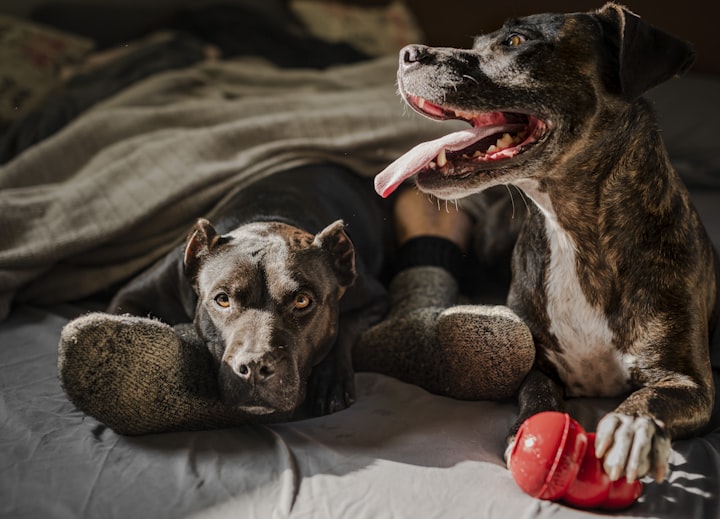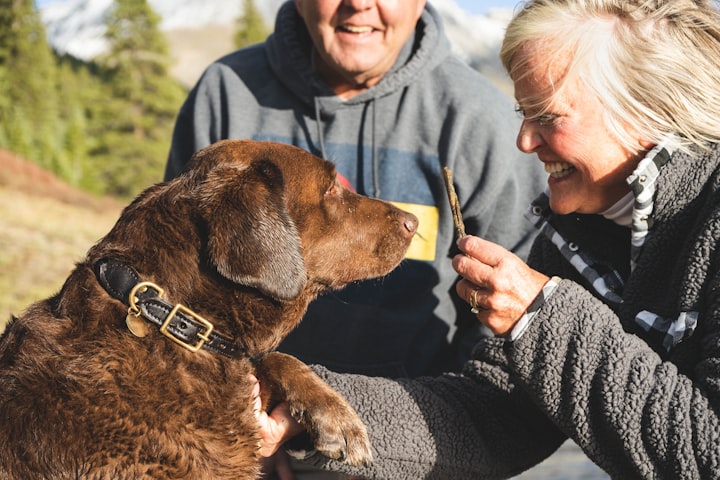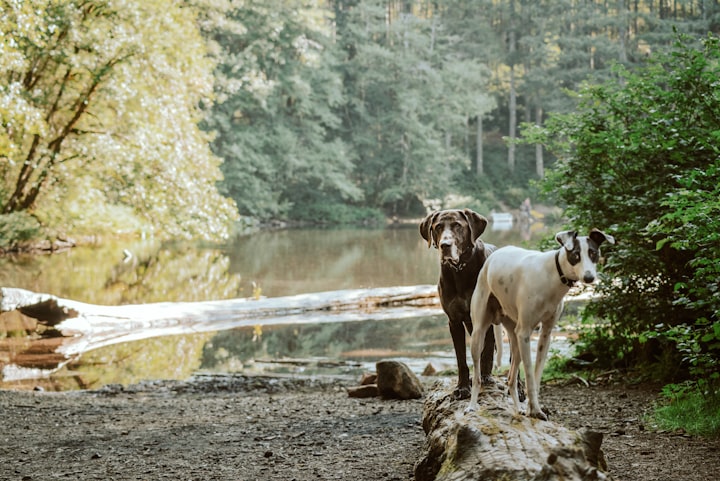
Welcoming a dog into your life brings immeasurable joy and companionship. Beyond being a pet, dogs have an innate ability to form deep emotional bonds with their human counterparts. Building a strong canine-human bond is not only rewarding but also crucial for the overall well-being and happiness of both you and your furry friend. In this blog, we will explore the significance of fostering a strong bond with your canine companion and provide practical tips on how to strengthen this connection.
I. Enhanced Communication:

Developing a deeper understanding of your dog's body language, facial expressions, and vocalizations not only strengthens your bond but also facilitates effective communication. Dogs communicate primarily through nonverbal cues, and by being attentive to these signals, you can establish a harmonious and mutually fulfilling relationship with your furry companion.
1. Body Language:
Dogs express their emotions and intentions through their body language. Understanding and interpreting their postures and movements will help you comprehend their current state of mind. For example:
- Tail position: A wagging tail can indicate happiness, while a tucked tail may signal fear or anxiety.
- Ears: Erect ears suggest alertness, while flattened or backward ears may indicate fear or submission.
- Eye contact: Direct eye contact can convey confidence or challenge, while avoiding eye contact can indicate submission or discomfort.
- Posture: A relaxed, loose posture typically signifies a calm and content dog, while a stiff or tense posture may indicate tension or aggression.
By observing your dog's body language, you can respond appropriately to their emotional state, address any discomfort, and reinforce positive behaviors.
2. Facial Expressions:
A dog's face can provide valuable insights into their emotions. Pay attention to the following facial cues:
- Eyes: Dilated or wide eyes can indicate fear or arousal, while squinted eyes often suggest relaxation or contentment.
- Mouth: A relaxed, slightly open mouth usually signifies a calm and comfortable state. Conversely, lips pulled back to expose teeth can indicate aggression or stress.
- Yawning: Contrary to human yawns, yawning in dogs can signal stress, anxiety, or an attempt to calm themselves down.
By familiarizing yourself with your dog's facial expressions, you can better understand their emotional state and respond accordingly with reassurance or appropriate action.
3. Vocalizations:
While dogs primarily rely on nonverbal communication, their vocalizations also convey important messages. Understanding different types of vocalizations will help you gauge your dog's needs and emotions:
- Barking: Dogs bark for various reasons, such as alerting, expressing excitement, or indicating anxiety or fear. Pay attention to the pitch, duration, and intensity of their barks to decipher their intended message.
- Whining or whimpering: These vocalizations may indicate discomfort, pain, or a desire for attention.
- Growling or snarling: These vocalizations are warning signs that your dog feels threatened or is exhibiting defensive behavior.
By recognizing and interpreting your dog's vocalizations, you can address their concerns, provide comfort, or modify their environment to alleviate stress or anxiety.
4. Practice Active Listening:
To establish effective communication, actively listen to your dog's cues and respond appropriately. Show genuine interest and engage with your dog during interactions. Take note of their preferences, dislikes, and individual personality traits. This active listening helps build trust, strengthens the bond, and reinforces the understanding that you value their needs and desires.
Enhancing communication with your dog through understanding their body language, facial expressions, and vocalizations is vital for building a strong bond and fostering a harmonious relationship. By paying close attention to these cues and responding appropriately, you can establish trust, mutual respect, and effective communication with your furry friend. This deeper level of understanding will not only strengthen your bond but also enhance the overall well-being and happiness of both you and your beloved canine companion.
II. Trust and Loyalty:

The Cornerstones of a Strong Canine-Human Bond
Trust serves as the foundation for any successful relationship, and the bond between you and your dog is no exception. Building trust is a crucial element in fostering a deep and meaningful connection. When your dog trusts you, they feel secure, loved, and protected. This trust forms the basis for loyalty, an innate characteristic that dogs are renowned for. Let's delve into the significance of trust and loyalty in your relationship with your furry companion.
1. Demonstrating Reliability:
Reliability is a key factor in establishing trust with your dog. Consistency in your actions, routines, and care for your dog creates a sense of predictability and reliability in their lives. By providing regular meals, adhering to a consistent schedule for walks and playtime, and maintaining a stable environment, you demonstrate that you are dependable and trustworthy. Your dog learns to rely on you to meet their basic needs, which fosters a sense of security and confidence in your relationship.
2. Meeting Their Needs:
Meeting your dog's physical and emotional needs is an essential aspect of building trust. Ensuring they have access to nutritious food, fresh water, proper medical care, and a safe environment communicates that you prioritize their well-being. Additionally, addressing their social and mental needs through exercise, socialization, and mental stimulation helps create a fulfilling and enriching life for your dog. By consistently meeting their needs, you build trust and demonstrate your commitment to their happiness and overall quality of life.
3. Respect and Understanding:
Respect and understanding are vital components of trust-building. Recognize and acknowledge your dog's individuality, personality, and boundaries. Respect their personal space, body language, and communication cues. For example, if your dog shows signs of discomfort in certain situations, such as meeting new people or being in crowded areas, honor their boundaries and create a safe environment for them. Understanding their needs, preferences, and limitations helps establish trust and promotes a harmonious relationship built on mutual respect.
4. Providing Security and Protection:
Dogs instinctively seek safety and protection from their human companions. Creating a secure environment for your dog to thrive is a significant way to build trust. This includes ensuring their physical safety by using appropriate restraints, such as leashes or fences, and providing a comfortable and cozy space where they can rest and relax. Additionally, protecting them from potentially harmful situations, such as avoiding dangerous foods or toxic substances, reinforces their trust in your role as their caregiver and protector.
5. Loyalty and Devotion:
Dogs are known for their unwavering loyalty and devotion to their human companions. When trust is established, your dog's loyalty deepens, and their bond with you strengthens. Loyalty manifests in various ways, such as eagerly seeking your company, demonstrating protective instincts, and remaining steadfastly by your side. Your dog's loyalty is a testament to the trust they have in you, and it forms a powerful and enduring connection that enriches both your lives.
Trust and loyalty are fundamental elements in cultivating a strong canine-human bond. By demonstrating reliability, meeting their needs, showing respect and understanding, providing security and protection, and fostering loyalty, you create a safe and secure environment for your dog to thrive. Trust serves as the bedrock of your relationship, laying the groundwork for mutual love, companionship, and happiness. When trust and loyalty are nurtured, your bond with your furry companion becomes unbreakable, resulting in a deep and meaningful connection that brings immeasurable joy and fulfillment to both of your lives.
III. Positive Behavioral Development:

Shaping Your Dog's Behavior Through a Strong Canine-Human Bond
A strong bond between you and your dog plays a crucial role in their behavioral development. Dogs who feel deeply connected to their owners are more inclined to exhibit desirable behaviors and readily comply with commands. By utilizing positive reinforcement training methods and maintaining consistent interaction, you can foster obedience, respect, and a sense of cooperation in your furry companion. This bond becomes a catalyst for shaping their behavior and contributes to creating a well-rounded and balanced dog.
1. Positive Reinforcement:
Positive reinforcement is a highly effective training method that relies on rewarding desired behaviors. When your dog exhibits good behavior, such as following commands, displaying calmness, or showing appropriate social skills, reward them with treats, praise, or affection. This positive association strengthens their understanding of what is expected and motivates them to repeat those behaviors in the future. Positive reinforcement builds confidence, trust, and a willingness to engage in learning, leading to positive behavioral development.
2. Consistent Interaction:
Regular and consistent interaction with your dog is essential for behavioral development. Spend quality time engaging in activities that strengthen your bond, such as daily walks, interactive play sessions, or training exercises. Consistency in your interactions establishes clear communication and reinforces your role as the leader and provider of guidance. Through these interactions, your dog learns to trust and respect your authority, which paves the way for cooperative behavior.
3. Socialization:
Proper socialization is crucial for your dog's behavioral development. Exposing them to various people, animals, environments, and experiences in a positive and controlled manner helps them become confident, well-adjusted, and friendly. Socialization fosters adaptability and reduces the likelihood of fear or aggression towards unfamiliar situations. Your active participation in their socialization process further strengthens your bond and reinforces your role as their trusted companion.
4. Clear Boundaries and Expectations:
Establishing clear boundaries and expectations is essential for shaping your dog's behavior. Clearly communicate what behaviors are acceptable and provide consistent guidance to correct inappropriate ones. Dogs thrive when they understand the rules and expectations set by their owners. By using positive reinforcement to reward desired behaviors and redirecting or ignoring unwanted behaviors, you shape their understanding of what is appropriate, further strengthening your bond.
5. Training and Mental Stimulation:
Training sessions not only teach your dog important commands and cues but also provide mental stimulation. Engaging their minds through obedience training, puzzle toys, or interactive games prevents boredom and destructive behaviors. Positive training methods, such as clicker training or reward-based training, reinforce your bond and create a positive learning environment. Regular mental stimulation and training sessions foster focus, obedience, and a strong connection between you and your dog.
Positive behavioral development in your dog is greatly influenced by the strength of your canine-human bond. By employing positive reinforcement training methods, engaging in consistent interaction, prioritizing socialization, establishing clear boundaries, and providing mental stimulation, you shape their behavior and nurture a well-rounded and balanced dog. This bond acts as a guiding force, motivating your dog to exhibit desirable behaviors, respect your authority, and actively participate in their own development. The positive behavioral outcomes of a strong bond create a harmonious and fulfilling relationship, enhancing both your lives and deepening the connection you share with your beloved furry companion.
IV. Emotional Well-being:

Nurturing Your Dog's Emotional Health Through a Strong Canine-Human Bond
Dogs are social creatures with complex emotional needs. Building a strong bond with their human companion plays a vital role in fulfilling these needs, providing them with a sense of belonging, purpose, and emotional security. Dogs who feel deeply connected to their owners are less prone to separation anxiety, stress, and behavioral issues. Through regular physical affection, quality time spent together, and understanding their individual personality, you can contribute to their overall emotional well-being and happiness.
1. Sense of Belonging:
Being a part of a pack is deeply ingrained in a dog's nature. By establishing a strong bond with your dog, you create a sense of belonging and inclusion. They see you as their trusted leader and an integral part of their pack. This sense of belonging provides them with emotional security and reduces feelings of loneliness or isolation. Regularly engaging in activities together, such as walks, playtime, or simply being present, reinforces their sense of belonging and strengthens your bond.
2. Physical Affection:
Physical affection is a powerful tool in nurturing your dog's emotional well-being. Regularly offering gentle touches, hugs, and cuddles helps them feel loved, cared for, and emotionally supported. Petting your dog releases oxytocin, a hormone associated with bonding and relaxation, promoting a sense of calm and contentment. Each touch is a reassurance of your love and strengthens the emotional connection between you and your furry companion.
3. Quality Time:
Devoting quality time to your dog is essential for their emotional health. Set aside dedicated moments each day to engage in activities that they enjoy. This can include interactive play sessions, training exercises, or exploring the outdoors together. Quality time spent together strengthens your bond, deepens your understanding of each other, and fosters a sense of companionship. It provides mental stimulation, emotional fulfillment, and a shared sense of joy.
4. Understanding Their Personality:
Each dog has a unique personality, with their own likes, dislikes, and emotional sensitivities. Taking the time to understand and appreciate your dog's individuality is crucial for their emotional well-being. Observe their body language, facial expressions, and vocalizations to decipher their feelings and emotions. Respect their boundaries, fears, and preferences, and tailor interactions and activities to their comfort level. Understanding their personality fosters trust, emotional security, and a stronger bond.
5. Emotional Security:
A strong bond with their human companion provides dogs with a sense of emotional security. They rely on you for protection, comfort, and guidance. Establishing routines, maintaining a stable and predictable environment, and consistently meeting their physical and emotional needs create a safe and secure space for your dog to thrive. This emotional security reduces anxiety, stress, and behavioral issues, promoting their overall emotional well-being.
Nurturing your dog's emotional well-being through a strong canine-human bond is essential for their happiness and overall quality of life. By providing a sense of belonging, offering physical affection, spending quality time together, understanding their unique personality, and ensuring emotional security, you create an environment that fosters emotional well-being. Your love, care, and commitment contribute to their emotional fulfillment and strengthen the bond you share. The emotional connection you cultivate with your furry companion enhances their lives and enriches your own, creating a lifelong partnership built on love, trust, and emotional well-being.
V. Strengthened Companionship:

Deepening the Bond Between You and Your Canine Companion
Building a strong canine-human bond goes beyond the role of a pet owner. It transforms your dog into a beloved companion, an integral part of your life, and a cherished member of your family. Through shared experiences, adventures, and everyday moments, this bond evolves into a unique connection that brings joy, comfort, and a deep sense of fulfillment to both you and your dog. Let's explore how a strong bond enhances the companionship you share.
1. Shared Experiences:
Engaging in shared experiences forms the foundation of companionship. Whether it's exploring new places, embarking on outdoor adventures, or simply enjoying quiet moments together, these shared experiences create lasting memories and strengthen your bond. The joy and excitement you both experience in these moments foster a deep sense of connection and create a shared language of love and understanding.
2. Unconditional Love and Acceptance:
A strong bond with your dog is rooted in unconditional love and acceptance. Regardless of the circumstances, your dog loves you unconditionally and accepts you for who you are. This unwavering support creates a safe and non-judgmental space, allowing you to be your authentic self. The mutual acceptance and love build a companionship that is built on trust, empathy, and the freedom to be vulnerable.
3. Emotional Support:
Companionship with your dog provides emotional support during both happy and challenging times. Dogs have an innate ability to sense and respond to your emotions. They offer comfort, a listening ear, and a comforting presence when you're feeling down or stressed. Their unconditional love and unwavering loyalty provide a source of emotional solace, helping you navigate through life's ups and downs.
4. Improved Mental and Physical Well-being:
The companionship of a dog has been shown to have numerous benefits for your mental and physical well-being. Spending time with your dog can reduce stress, lower blood pressure, and release endorphins that promote feelings of happiness and well-being. The bond you share motivates you to stay active, engage in physical activities, and lead a healthier lifestyle. The presence of your dog creates a positive and uplifting environment, contributing to your overall well-being.
5. Enhanced Communication:
A strong bond with your dog deepens your communication and understanding. Over time, you become attuned to each other's needs, desires, and cues. Through a combination of verbal and non-verbal communication, you develop a unique language that transcends words. This enhanced communication strengthens the connection between you and your dog, allowing you to anticipate each other's needs and desires, fostering a deeper sense of companionship.
A strong canine-human bond transforms your dog into more than just a pet; they become an irreplaceable companion and a cherished member of your family. Through shared experiences, unconditional love and acceptance, emotional support, improved well-being, and enhanced communication, this bond deepens the companionship you share. The joy, comfort, and fulfillment derived from this relationship enrich your lives and create a lifelong partnership filled with love, loyalty, and endless moments of companionship.
In conclusion, building a strong canine-human bond is of utmost importance for both the dog and the owner. This bond not only enhances the overall well-being and happiness of the dog but also fosters a deeper understanding, trust, and communication between the two. A strong bond allows for effective training, seamless integration into the family, and a lifetime of love, companionship, and shared experiences. Investing time and effort into building this bond creates a harmonious and fulfilling relationship that enriches the lives of both humans and their canine companions.
About the Creator
Caninepaw
Welcome to Canine Connection Blog, where we bring together a community of dog lovers






Comments
There are no comments for this story
Be the first to respond and start the conversation.